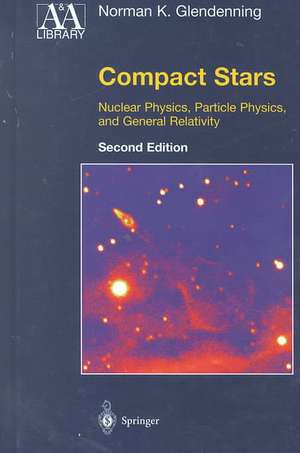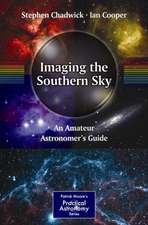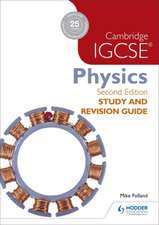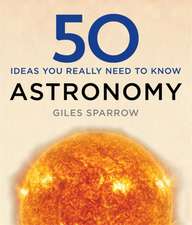Compact Stars: Nuclear Physics, Particle Physics, and General Relativity: Astronomy and Astrophysics Library
Autor Norman K. Glendenningen Limba Engleză Hardback – 16 iun 2000
| Toate formatele și edițiile | Preț | Express |
|---|---|---|
| Paperback (1) | 593.42 lei 6-8 săpt. | |
| Springer – 27 sep 2012 | 593.42 lei 6-8 săpt. | |
| Hardback (1) | 794.39 lei 6-8 săpt. | |
| Springer – 16 iun 2000 | 794.39 lei 6-8 săpt. |
Din seria Astronomy and Astrophysics Library
- 17%
 Preț: 496.38 lei
Preț: 496.38 lei - 15%
 Preț: 601.60 lei
Preț: 601.60 lei - 19%
 Preț: 455.25 lei
Preț: 455.25 lei - 17%
 Preț: 525.74 lei
Preț: 525.74 lei - 13%
 Preț: 393.37 lei
Preț: 393.37 lei - 19%
 Preț: 524.15 lei
Preț: 524.15 lei - 17%
 Preț: 393.90 lei
Preț: 393.90 lei - 15%
 Preț: 647.40 lei
Preț: 647.40 lei - 15%
 Preț: 541.54 lei
Preț: 541.54 lei - 17%
 Preț: 362.71 lei
Preț: 362.71 lei - 18%
 Preț: 1006.55 lei
Preț: 1006.55 lei - 18%
 Preț: 745.33 lei
Preț: 745.33 lei - 15%
 Preț: 641.20 lei
Preț: 641.20 lei -
 Preț: 397.38 lei
Preț: 397.38 lei - 15%
 Preț: 598.21 lei
Preț: 598.21 lei - 15%
 Preț: 658.05 lei
Preț: 658.05 lei - 23%
 Preț: 815.09 lei
Preț: 815.09 lei -
 Preț: 409.89 lei
Preț: 409.89 lei - 15%
 Preț: 610.61 lei
Preț: 610.61 lei -
 Preț: 393.90 lei
Preț: 393.90 lei - 15%
 Preț: 655.27 lei
Preț: 655.27 lei - 18%
 Preț: 951.47 lei
Preț: 951.47 lei - 18%
 Preț: 960.42 lei
Preț: 960.42 lei - 18%
 Preț: 1397.68 lei
Preț: 1397.68 lei - 18%
 Preț: 959.98 lei
Preț: 959.98 lei - 18%
 Preț: 1012.08 lei
Preț: 1012.08 lei - 15%
 Preț: 481.03 lei
Preț: 481.03 lei - 15%
 Preț: 672.43 lei
Preț: 672.43 lei -
 Preț: 413.15 lei
Preț: 413.15 lei - 18%
 Preț: 1554.72 lei
Preț: 1554.72 lei - 18%
 Preț: 1410.63 lei
Preț: 1410.63 lei -
 Preț: 390.08 lei
Preț: 390.08 lei - 18%
 Preț: 944.99 lei
Preț: 944.99 lei - 19%
 Preț: 502.94 lei
Preț: 502.94 lei - 15%
 Preț: 654.12 lei
Preț: 654.12 lei - 24%
 Preț: 851.64 lei
Preț: 851.64 lei - 19%
 Preț: 515.34 lei
Preț: 515.34 lei - 15%
 Preț: 663.14 lei
Preț: 663.14 lei - 15%
 Preț: 656.43 lei
Preț: 656.43 lei - 18%
 Preț: 741.68 lei
Preț: 741.68 lei - 15%
 Preț: 647.40 lei
Preț: 647.40 lei -
 Preț: 388.90 lei
Preț: 388.90 lei - 18%
 Preț: 1217.72 lei
Preț: 1217.72 lei - 15%
 Preț: 651.51 lei
Preț: 651.51 lei - 15%
 Preț: 655.27 lei
Preț: 655.27 lei -
 Preț: 347.60 lei
Preț: 347.60 lei
Preț: 794.39 lei
Preț vechi: 968.76 lei
-18% Nou
152.02€ • 165.08$ • 127.70£
Carte tipărită la comandă
Livrare economică 22 aprilie-06 mai
Specificații
ISBN-10: 0387989773
Pagini: 492
Ilustrații: XVIII, 468 p.
Dimensiuni: 155 x 235 x 32 mm
Greutate: 0.8 kg
Ediția:2nd ed. 2000
Editura: Springer
Colecția Springer
Seria Astronomy and Astrophysics Library
Locul publicării:New York, NY, United States
Public țintă
GraduateCuprins
Recenzii
"Deals thoroughly with the equations of state, the structure and constitution of white dwarfs, and neutron stars ... It contains material that can be hard to find elsewhere."
THE OBSERVATORY
Descriere
White dwarfs, neutron stars, and (solar mass) black holes are the collapsed cores of stars which, near the ends of their luminous lives, have shed most of their mass in supernova explosions or other, less spectacular, instabilities. Here gravity crushes matter to realms that lie far beyond present empirical knowledge. This book explores the diverse forms that such compact stars can possibly take, as constrained by the laws of nature: the general principles of relativity and quantum mechanics, the properties of nuclear matter deduced from nuclei, and the asymptotic freedom of quarks at high density. The book is self contained. It reviews general relativity, essential aspects of nuclear and particle physics, and general features of white dwarfs, neutron stars and black holes; it includes background on such matters as stellar formation and evolution, the discovery of pulsars and associated phenomena, and the strange-matter hypothesis. The book develops a theory for the constitution of neutron stars and the more exotic Hyperon Stars, Hybrid Stars (containing a quark matter core surrounded by an intricate lattice of quark and hadronic matter) and Strange Stars and Dwarfs (composed of the three light quark flavors sheathed in a solid skin of heavy ions). This second edition has been revised throughout to clarify discussions and bring data up to date; it includes new figures, several new sections, and new chapters on Bose condensates in neutron stars and on phase transitions.












